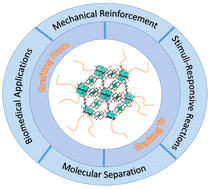Polymer-grafted metal–organic frameworks: design, synthesis, and applications
Abstract
Metal–organic frameworks (MOFs) have become some of the most promising and widely applied materials in the 21st century owing to their high surface area and unmatched versatile functionalities. By combining MOFs with polymer matrices, one can potentially achieve novel composite materials that maintain merits of both components. However, pristine MOFs without surface modification often do not possess favorable interactions with the surrounding environment, such as a solvent or a polymer matrix, due to a mismatch of chemical and physical properties. The inevitable consequences include poor interface and undermined overall performance. To overcome these issues, grafting polymers onto MOF surfaces has been widely utilized because of the wide range of chemical moieties and properties of polymers. In this review, we provide a detailed discussion on the design and synthesis of polymer-grafted MOF particles, outlining different polymerization techniques and grafting reactions that have been successfully demonstrated on MOF surfaces. In addition, we summarize the advantages of polymer-grafted MOFs while focusing on unique properties or enhanced performances that were the result of the polymer grafts. Various applications, such as biomedical imaging and sensing, molecular separation, and stimuli-responsive reactions are covered in detail, with a focus on surface-anchored polymers. This review concludes with an outlook on the current challenges in polymer-grafted MOFs, which will shed light on future design and applications of these emerging materials.

- This article is part of the themed collections: Fundamentals and Applications of Functional Framework Materials and Journal of Materials Chemistry C Recent Review Articles


 Please wait while we load your content...
Please wait while we load your content...